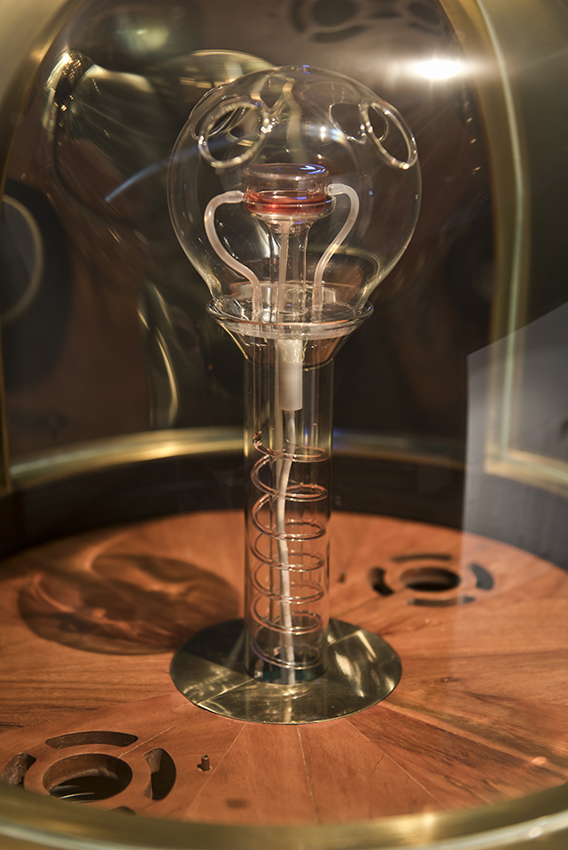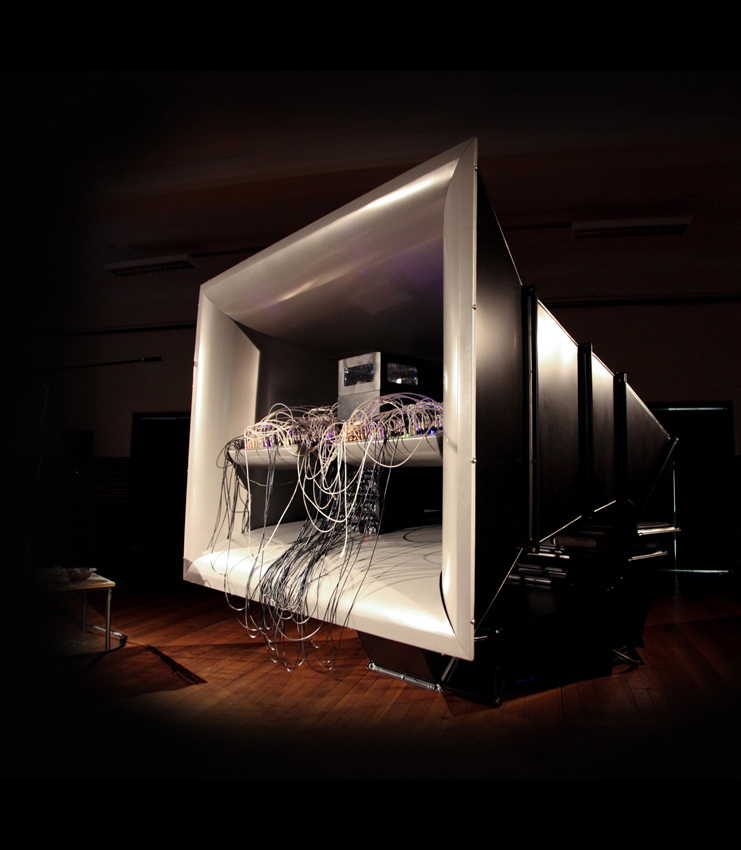LAZNIA 1 the new publication from the
At the begining this year, is published next one, bilingual publication from the "Art+Science Meeting" series - "Bio-Robotic Art and its Cultural Contexts". This album is devoted to the art of Guy Ben-Ary, whose exhibition "Nervoplastica" was presented at the Laznia CCA last June. The editor of the publication is the curator of the project, Prof. Ryszard Kluszczyński, whose introduction you will find below. You may download a fragment of the publication here:
Semi-living Art in Search of an Autor
The biography of Guy Ben-Ary, an Israeli artist born in the United States and living for many years in Australia, corresponds well in its nomadic complexity with the character of the works he creates. Indeed, his art combines in its multi-layered references and associations numerous trends in contemporary art. It is in their dynamic, transdisciplinary coexistence and interactions with technologies, materials, working methods, and the rules of aesthetics, that the multimedia, hybrid works of Ben-Ary emerge, works that offer the audience an equally complex form of aesthetic experience.
The artistic trends, media and disciplines that come together and interact with one another in Ben-Ary’s creative projects, thereby defining his work, can be clustered into three groups. The first comprises bioart and robotic art, as well as the derivative genre forms that sometimes emerge from interactions between them; the second consists of art installations and conceptual art; in the third, I would place net art, cinema and sound art, as well as innovative treatments of two traditional fields of the fine arts: drawing and sculpture. I do not treat this as a closed list; I have included in it only those types of art that have a significant presence in Guy Ben-Ary’s oeuvre. It should be also noted that the trends placed together in the first two groups define the whole of his art, collectively comprising its fundamental aspects, while the disciplines contained in the third group play a role merely in shaping particular works. The artistic character of each project derives from interactions among the above-mentioned areas of creative practice that take place both within particular groups and between them.
Two additional theses ensue from the claims made above. First, the aesthetics of Guy Ben-Ary’s works are founded on trans-genre relationships. These aesthetics are transgressive and nomadic. Secondly, each of the three groups of tendencies and artistic disciplines present in Ben-Ary’s works fulfils a different function in them.
The most important role is played by the first group. Two disciplines are contained within it: bioart, and, in particular, art based on tissue culture and engineering, and robotic art, which defines the basic conceptual framework and artistic character of Ben-Ary’s works. This has led his work to become part of the dynamically growing and internally diverse area referred to as ‘art & science’, and this affiliation has become the primary frame of reference for his art. Alongside this, manifested in the work of the author of cellF is the issue of new hybrid forms of life, and analyses of their agency and ability to communicate.
The second group, in turn, indicates the structural and meta-artistic dimensions of Ben-Ary’s art. His works usually take on the form of an installation. The artistic discourse that emerges from them is, above all, a dialogue between the features that define an art installation and the artistic properties of the other disciplines he engages in various works, and then contrasting the two perspectives engaged, that is, the interplay between the artistic and scientific aspects of the works. The final form of Ben-Ary’s work, which belongs to the field of art & science, emerges out of the system that results, encompassing all of these relationships. Meta-artistic aspects of his work, which are extremely important to it, also emerge from the interaction between its artistic and scientific components. The effect is theoretical and aesthetic reflection on the basic elements of the aesthetic experience: the work, authorship, creation, and reception. A deconstruction of these basic concepts – a manifestation of the conceptual nature of these works – can be added to the basic properties of the analyzed work.
The media and artistic fields that make up the third group also play a role in the development of the artistic and meta-artistic nature of Ben-Ary’s art; however, in contrast to the previously discussed disciplines, this applies only to particular works. In this way, by co-producing the aesthetics of particular projects, they complement the multimedial and trans-disciplinary image of the whole.
The description of the basic features of Guy Ben-Ary’s work presented thus far requires further development and expansion. The mutual interactions between biological art (involving tissue culture and engineering) and robotic art yields bio-robotic art. This could be considered a definitive term for the projects implemented by of the author of MEART – Semi-Living Artist. However, given the nature of the biological component used in all his works, that is, nerve cells, this tendency in his work should also be viewed in the context of neural art, also referred to as neuro-art.
For the past fifteen years, Guy Ben-Ary’s artistic practices have involved combining the creative arts with neurology and neuroengineering. His projects, produced in cooperation with scientists and other artists, are created at the intersection of bioart, new media art, and robot art, and assume a form, which – if we wanted to include all of its most important components – would be labelled (new media) bio/neural-robotic art. In his work, cultured neural networks serve as a living component that remains in interactive relationships with technical, digital or robotic elements. All his works are examples of the cultural use of neural cultures – a kind of brain produced by means of bioengineering manipulations.
In-Potēntia, a work by Guy Ben-Ary and Kirsten Hudson, is a sculpture that uses a cultured brain. In the installation The Living Screen, created by Ben-Ary together with Tanya Visosevic, living cells were integrated with a cinematographic camera, functioning as a screen for it. In the installation Snowflake, which Ben-Ary realized in cooperation with Boryana Rossa and Oleg Mavromatti, a neural network composed of rat cells was stimulated by the image of a snowflake in order to develop a memory or dream of it. MEART – Semi-Living Artist, a work created as a result of cooperation between Guy Ben-Ary, the SymbioticA laboratory, and Steve Potter’s neuroengineering lab, is a hybrid artist – an installation in which cultured neurons act as a brain influencing the creative activities of robotic arms. The installation Silent Barrage had a similar structure, character and team of authors. In turn, cellF – a cybernetic musician/composer – is made up of neural cultures taken from the artist himself, representing here an external brain (located in a mini-bioreactor) connected to a synthesizer body-sculpture. cellF produces sounds in response to auditory stimulation from outside, producing a reactive concert of improvised music.
All six works mentioned above, which form the main body of Guy Ben-Ary’s oeuvre, are hybrid forms linking art and science – bio-robotic projects produced within the art & science current. They bring neural forms grown in the lab into the cultural sphere as art projects, inviting the audience to experience and reflect on today’s emerging postbiological reality. They propose a new form of art, as much created as grown, as much authorial acts as collective ones, as much human as generated by non-human, autonomous agents.
In the above list and prefatory description of Guy Ben-Ary’s most important works, worthy of attention are a few aspects of his art not yet covered here.
Firstly, the collective nature of his creative work. All the works cited above resulted from the collective efforts of a number of people, both artists and scientists. This is the result, on the one hand, of the obvious necessity to involve co-workers with various necessary competences in the work (Henry Jenkins’ concept of ‘collective intelligence’); on the other hand, it is also clearly the result of the slow passing of artistic practices associated with the idea of Do It Yourself (DIY), dominant until recently in alternative circles, which is being replaced by a new concept – Do It With Others.
Secondly, there is the creative relationship between the art studio, the gallery and the laboratory. In Ben-Ary’s artistic activities, as with most phenomena from the art & science current, the science lab is increasingly becoming a space for artistic work. This is where all the necessary preparatory work relating to the biological components of the works is carried out – the artist’s studio is thus moving to the laboratory. Also residing there are the living components of his bio-robotic installations, integrated by means of an Internet-connected nervous system with digital dispositives and robotic components located throughout the gallery space – the lab becomes an active, participatory resource base for the exhibition space. And, finally, the laboratory is entering the gallery – works located in galleries are themselves becoming mini-labs or require direct support from laboratory tools and equipment located in the gallery, which ultimately becomes in this way a laboratory for living or semi-living art.
Thirdly, there is the living status of the work and its transient, temporary nature. Guy Ben-Ary creates works that are living (semi-living), and are therefore transitory by nature; they are terminal works, moving off into oblivion faster than their creators. This fact raises another important issue – the posthumous life of works of art. They become their documentation, tied to the results of their own creative activities, hybrid entities that are at once material, virtual and imaginary, past and present.
This book follows in the wake of Guy Ben-Ary’s NERVOPLASTICA exhibition (co-authored with Kirsten Hudson, Tanya Visosevic, Boryana Rossa, and Oleg Mavromatti), held at the Łaźnia Centre for Contemporary Art in Gdańsk in May of 2015. Although it was prepared by an international group of experts on the links between art and science, and, in particular, biological and bio-robot art, the scope of its interests is not limited to the works of Ben-Ary and his associates. His work remains at the centre of the interests of each of the authors, but analysis of his work is accompanied by reflections on a number of contexts, including the general phenomenon of art & science, the problems of post- and trans-humanism, and issues related to postdisciplinarity and hybridization, the Anthropocene and accelerationism, transformations in aesthetics, information theory, and the critical theory of culture. Being the first monograph on Ben-Ary’s works, the book is both an introduction to the issues involved in bio-robotic art and its theoretical, cultural, and philosophical underpinnings.

photo_1 | Guy Ben-Ary at his studio – one of Symbiotica’s labs at the University of Western Australia, photo courtesy of the artist

photo_2 | MEART – The Semi-Living Artist, 2001–2006, photo Philip Gamblen

photo_3 | In-Potēntia, NERVOPLASTICA, Centre for Contemporary Art Laznia, Gdańsk 2015, photo Paweł Jóźwiak

photo_4 | Snowflake, NERVOPLASTICA, Centre for Contemporary Art Laznia, Gdańsk 2015, photo Paweł Jóźwiak

photo_5 | Bioprojector The Living Screen, NERVOPLASTICA, Centre for Contemporary Art Laznia, Gdańsk 2015, photo Paweł Jóźwiak

photo_6 | cellF performans, fot. dzięki uprzejmości artysty / cellF performance, photo courtesy of the artist







 BIP
BIP